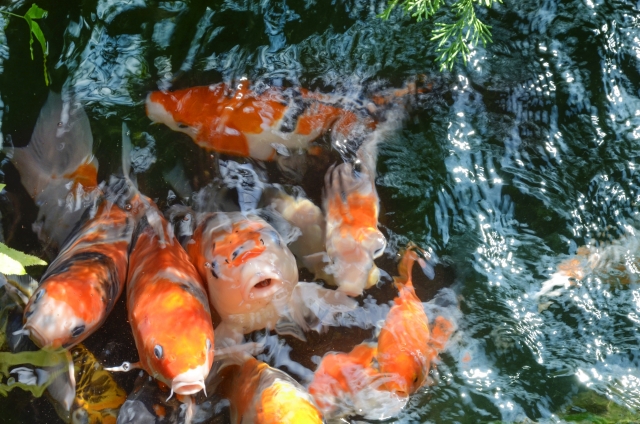<<華厳譜、普賢菩薩、棟方志功、1936年(1938年摺)>>
In Ancient Greek, “look” was the most highly ranked verb among all human activities, I once read so. Look, see, watch, glance, stare, observe, or peep, they are all in the same category in this context. Look through things as they are, purely and simply. It isn’t required any conscious efforts, therefore it is the supreme luxurious act.
古代ギリシア語では、「見る」という動詞が人間の持つ営みの中で最も高い位にある動詞だった、いうことを読んだことがある。見るは見るでも、観る、視る、診る、と日本語にも色々表現はあるけれど。英語だとlook, see, watch, glance, stare, observe, peep, ともっと多くなる。純粋にただそこにあるものをじっと見つめるということは、努力なるものを一切要しない、贅沢の極致だ。

I was recalling such things when visiting MUNAKATA Shiko’s art exhibition. MUNAKATA (1903~1975) started his career form painting, and moved on to woodblock printing, later he was recognized as “MUNAKATA of the world”
そして、そんなことを思い出した棟方志功展である。棟方志功(1903~1975) は絵画から出発し、やがて版画表現に移り、そして世界に認められ「世界のムナカタ」になって行った。

According to the catalogue I bought, it was introduced his words “I’ll be Van Gogh.”, and relations with Art and Crafts Movement. But putting aside such knowledge, I was able to witness his passionate breathing, looking closely. It was climax of extravagance, in a sense.
購入した図録によれば、「わだばゴッホになる。」という言葉や、民藝運動との関わりなど色々書かれているけれど、そんな知識云々ではなく、ただ純粋に、そこにあった棟方志功の情熱ほとばしる息遣いを、顔を作品に近づけて覗き込み、ありありと目撃することが出来た時間は、まさに贅沢の極みでもあった。




Confronting with art work in an exhibition, focusing on the work and observe in detail, then a big sigh leaks out. And purchase a catalogue wishing to bring back home the excitement. However, I always reach out the same conclusion that catalogue is capturing only 10% of pure energy that art piece is emitting.
美術展で作品と対峙し、じっと意識を集中させて、細部まで観察し、ほぉ〜と深いため息がこぼれ落ち、そしてその作品が纏う空気を持ち帰りたくて図録を購入する。けれど図録に載っている写真は、本物が放っている純粋熱量を一割くらいしか写し出していないといつも思う。

It’s worthwhile to have those catalogues for reference, and art books are my treasure. Even though, one and only genuine work that artist creates with heart and soul is impossible to carry around after processing. By the very reason, to go visit the place actually and see through works with your own eyes turns to be one of a kind pure experience.
資料として持っておく価値はあるし、図録や画集は自分に取っては宝物なのだけれども、世界に一つの実際に作家が精魂込めて作り上げた作品というものの真髄は、加工して持ち運ぶことはそもそも不可能なのだ。だからこそ、自分の足を運び、実際にこの目でしかと見る、ということが価値ある純粋経験となってくる。







MUNAKATA left many works themed Buddhism, and Christianity some. And many works represented prayer for world peace. The act of seeking for religious teaching or faith is not necessarily noble. But to pray and to live life practicing prayers is genuine. That time art is empowered and light of life shines through. It is the universal rule that is penetrating the world. I was thinking and walking in the venue.
棟方志功は仏教に関するテーマで多くの作品を残しているし、キリスト教に関する作品もあり、世界平和への祈りも多く表現されていた。宗教というものの教義や信仰を追い求めることが尊いのではなく、祈る、そして祈りを実践した生き方を貫く、という営みこそに真髄があるのだと。その時、芸術に力が宿り、そこに生命の光が差すのだというようなことを考えた。それは先人たちが刻んできた、遍くこの世界に流れる法則でもある。

And here comes breast. Breast is eternal motif for artists throughout the history, regardless time and place. MUNAKATA is no exception. Breast is beautiful and graceful more than anything, as a woman I also think so. Psychiatrist DOI Takeo analyzed as “longing for breast” in ‘The Anatomy of Dependence’, but even if not knowing such analysis, we all know the mystery of breast by nature.
そして、おっぱいである。おっぱいは、画家にとって古今東西永遠のモチーフで、棟方志功も例外ではない。おっぱいは、やはり何よりも美しいと、女性である私もそう思う。「乳恋う」ということを精神科医の土居健郎が『「甘え」の構造』の中で分析していたが、そんな分析なんぞ知らずとも、全ての人はおっぱいの神秘を本能で知っている。

Breast is the spring of creation, not destruction. Anyone knows that. And that’s one of the reasons we love and cherish breast, it is programmed in our genes.
おっぱいは、破壊ではなく創造の泉だ。そんなことは、誰だって知っている。知っているからこそ、おっぱいを人は深く愛するのだと、私達の遺伝子にそう書き込まれている。



Each one of us completes making art of own by taking whole life. D.T. Suzuki wrote so, and it is our given and gifted mission not giving up oneself despite all challenges and setbacks. I was repeatedly thinking so, again this time.
人は生涯をかけて、その人自身の芸術を完成させてゆく。そう鈴木大拙が書いていたけれど、いかに自分を諦めずにその道を進んでゆくのかが、私たち一人一人に与えられた人生の課題なのだなあ。ということを、今回もやはり繰り返し考えていた。
Love and Peace…

参考文献
『図録 生誕120年棟方志功展 ミイキング・オブ・ムナカタ』発行NHK、 NHKプロモーション、2023年
『「甘え」の構造』土居健郎、弘文堂、1971年初版






















